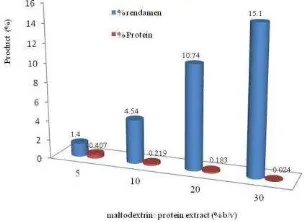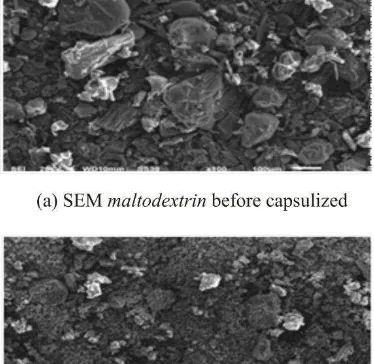Volume!10,!Number!15!!(2015)!!! !!
!!
CONTENTS! !!
! !
On!Demand!Replica!Management!of!ApplicaDon!Servers!with!Service!Level!Agreements!for!Quality!of!Service!Improvement! pp!35253N35257!
J.Parthasarathy!and!R.S.D.!Wahidabanu! !
Shortest!Energy!Based!OpDmal!Route!In!Zigbee!Mesh!Network! pp!35258N35260!
T.Senthil!Murugan! !
EncapsulaDon!of!proteinextractof!phytoplanktonandits!applicaDoninsago!starch!from!North!Maluku! pp!35261N35263!
DeasyLiesDanty,!Muliadi,!IrdhawaD,!Khadijah,!PaDmah,!and!Indah!RodianawaD! !
A!novel!rangeNfree!localizaDon!algorithm!based!on!opDmal!anchor!placement!and!reliable!anchor!selecDon!in!wireless!sensor! network!
pp!35264N35271!
Priya!Dev!Anand,!Hyunjae!Woo!and!Chaewoo!Lee! !
Non!linear!vibraDons!and!bending!stresses!of!symmetrically!laminated!composite!skew!plates! pp!35272N35277!
Hanane!Moulay!Abdelali!and!Rhali!Benamar! !
Effect!of!pH!and!Total!Hardness!on!Stability!of!Crude!Oil!Water!in!Oil!Emulsions! pp!35278N35281!
Hamed!Ma`ar!ALNqamshouai,!L.Nageswara!Rao!and!S.Feroz! !
ApplicaDon!for!sharing!movie!informaDon!based!on!open!API!and!GCM! pp!35282N35286!
International Journal of Applied Engineering Research ISSN 0973-4562 Volume 10, Number 15 (2015) pp 35261-35263 © Research India Publications. http://www.ripublication.com
35261
Encapsulation of protein extract of phytoplankton and its application in
sago starch from North Maluku
1)
Deasy Liestianty, 1)Muliadi, 2)Irdhawaty, 1)Khadijah, 3)Patimah 1)
Dept. of Chemistry Education, Khairun University 2)
Dept. of Chemistry, Udayana University 3)
Dept. of Chemical Engineering, Universitas Muslim Indonesia E-mail: [email protected]
Abstract- Encapsulation of protein extract of phytoplanktonwas conducted. The research aims at testing thefeasibility of phytoplanktonextractsto be usedin encapsulated sago food with maltodekstrin. The analysis method was Lowry andscanning electron microscopy (SEM). The results indicated that protein extracts of Dunaliellasalina had a high rendament content after encapsulating process, respectively 1.4 % and 0.407 % while the application of maltodekstrin was 5 percent. The highest protein content after the application of 30 % of protein extract of Dunaliellasalina to sago starch products was 9.19 mg/g.
Keywords- Encapsulation, phytoplankton, maltodextrin, sago starch, North Maluku.
1. Introduction
Indonesia is an agricultural country that is growing and developing from agriculturalsector. The main problem of agriculture is the availability offood for the population. An attempt to homogenizationof rice consumption has causedsome regions which are not potential for rice to grow to be dependent on rice supply from outside, this happens in North Maluku.
Sago are plant that grows massively in North Maluku. Although this region is potential to be a sago barn as the basis of food self-reliance, the government’s manifestation and modernization make the people consume rice rather than sago. All stakeholders need totake part tosustain thesagoas a staple food so foodself-sufficiency can be realized. In order to produce qualified food, sagoshould containhigh nutritional value. For sago loses many nutrients during the process into sago flour, it is considered necessary to give safe and natural substances or food additives.
One of theefforts toimprove thenutritionalvalue ofsagois addingthe proteinextracts, vitamins, amino acids from phytoplankton extract. Phytoplankton contains potential chemical compounds such as proteins, pigments, chlorophylls and caretenoids), carbohydrates, amino acids, lipids, and hydro carbons. Phytoplankton has been widely usedfor thebenefit of mankind, suchasfood ingredients, animal feed, medicines, fertilizer compoundandfuel source. The quality of phytoplanktoncan be sustainedthrough encapsulation method.
Encapsulation is a process or technique to overlay the core of the active compounds in the form of a solid, liquid, gas, or cells with a particular protective material that can
reduce the damage of the active compounds. Encapsulation helps separate the core material with its environment until the material is released into the environment. Protected core material is called the core and the structure formed by the protective material covering thenucleusis called the wall, membrane, orcapsule [2]. Capsule is a semi-permeable material, thin, round, and robust whose diameters varying from few micrometers to millimeters [1,2,8]. Encapsulation process also allows the conversion of a compound form of liquid into a spray drying. Spray drying is the drying of materials using high temperature. Principle of drying with a spray drying method is to spray the material in the form of droplets into a hot drying medium. Water in droplets evaporates and leaves the dry material [5,9].
2. Methods
2.1 CultivationandProduction ofPhytoplanktonBiomass; Phytoplankton cultivation was processed with the fed-batch culture system by periodically or randomly adding the media in which cultures were routinely harvested [3,6]. The process of harvesting was to filter phytoplankton biomass when the density of phytoplankton cell was high enough(cultural optical density optical >1) at day10th and 18th .
2.2 Extraction and analysis of phytoplankton biomass protein
Protein extractioncan beprocessed by Lorenz method. Protein was extracted from phytoplankton using 100mM of phosphate buffer solution pH7. Extraction procedure was committed by adding a phosphate buffer solution into a dry sample of phytoplankton to be extracted. The compounds ofphosphatebufferand phytoplankton were to be blended. The samples were storedin a refrigeratorat 10degreeCelsiusfor 24hours. The compounds were blended and centrifuged to separate the protein from phytoplankton biomass. Determination of protein content was done with Lowry and Kjehdal.
2.3 Selection of biopolymer and characterization ofthe encapsulatedproteinextract of products
2.4 The application of encapsulated protein extracts as additive material for sago starch products
A certain amount of encapsulated dry protein extracts was directly induced into sago starch. The mixture was done at room temperature for 24 - 48hours until the texture looked compact (encapsulated extracts were all mixed).
3. Result and Discussion
3.1 Cultivation and Biomass Harvesting.
Growing patterns of D. Salina, P. cruentum and T. chuii were observed every 24hours during growing periods. Figure 1 shows the growing period of each phytoplankton
Fig 1. Growth of phytoplankton cells during the cultivation and biomass production
The observation on the growth of D. Salina, P. cruentum and T. Chuii in medium Conwy was done every 24 hours for 14 days. Figure 2, generally shows a growing pattern composing of 4 phases; adaptation phase, exponential phase, stationary phase, and mortality phase. As seen in figure 1, the optimum growing period of D. Salina, P. Cruentum, and T. Chuii was on day8, 12, and 9. D. Salina with the highest protein content of 58% was selected as raw material based on cultivating time and the quantity of biomass. Furthermore, a semi-mass cultivation was conducted in a 100 liters water tank and so was the biomass harvesting.
3.2 Extractionandencapsulation of phytoplankton extracts The protein extraction of 2 grams of phytoplankton biomass was conducted using phosphate buffer pH7, 50mL was shaken by using a vortex, and then was stored in the refrigerator for 24hours. After 24hours, the compounds ware blended using a vortex and centrifugation by which protein solution (supernatant) was separated from biomass residues. Supernatant was stored in a refrigerator for further encapsulation process.
Bio polymers used for encapsulation was maltodextrin. Variation of the concentration ratio of protein extracts with 50 mL maltodextrin solution was5 % b/v, 10% b/v, 15% b/v and 20% b/v. Encapsulation of protein extracts was processed at inlet temperature 120oCandoutlet temperature 70oC with a flow rate/pump2. Rendament and encapsulated protein content is presented in table1 and figure 2.
As seen in table 1, the weight of extracted rendament protein on maltodextrin percentage is 1.4 (5%), 4.54 (10%), 10.74 (20%) and 15.1 (30%). The highest coating-maltodextrin percentage for D. Salina protein extract is 30% with rendament percentage of 15.1%.
Table 1. Rendament and encapsulated protein content
phytoplankton MD (%) Rendament (%) Protein (%)
Dunaliella saline 5 1.4 0.407
10 4.54 0.219
20 10.74 0.183
30 15.1 0.024
Figure 2 shows the content of maltodextrin-encapsulated D. Salina. The analysis of protein indicated that the highest protein was found in 5 percent-maltodextrin-encapsulated protein extract which later decreased while the percentage of maltodextrin in solution extract increased. D. Salina-capsulated protein content was 0.407 percent (5%), 0.219 percent(10%), 0183 percent (20%), 0.024 percent (30%).
Fig 2. Encapsulated extract rendament and protein content
3.3 Applicationofcapsulized proteininsagostarchproducts The measurement of protein in fortified phytoplankton extracts is presented in table 2 and figure 3.
Table 2 Protein content in fortified sago starch products
Protein:Sago (%b/b) Protein (mg/g)
5 0.98
10 1.6
20 3.87
30 9.19
International Journal of Applied Engineering Research ISSN 0973-4562 Volume 10, Number 15 (2015) pp 35261-35263 © Research India Publications. http://www.ripublication.com
35263 The results of protein measurement in fortified sago starch products (Table 2 and Figure 3) illustrates that the higher/more maltodextrin-capsulized-protein extract of phytoplankton is applied to sago starch caused to the higher protein. The highest protein content in sago starch added with capsulized protein extract was 30%, and the value of the protein content was 9.19mg/g
Figure 4a and 4b illustrate the measurement of
maltodextrin samples by scanning electron microscope
(SEM) (a) and sample of capsulized protein (b). Picture 4a,
maltodextrin before capsulized seemed to have large-sized particles, less solid, and shapeless compared with figure b. This indicates that the protein extract of phytoplankton was coated/encapsulated perfectly by bio polymers maltodextrin.
Fig 4. SEM analysis of a)Maltodextrin before encapsulized,(b) Protein extract after capsulized
4. Conclusion
From this research, it can be concluded that protein extract of
D. Salina can be encapsulated by maltodextrin. The highest content of protein extract afteren capsulation was 0.407 percent in rendament 1.4 percent. The highest protein content of sago starch after fortified with 30% phytoplankton protein was encapsulated 9.19 mg /g.
5. Acknowledgement
The authors would like to express the gratitude to the Ministry of Research and Technology of the Republic of Indonesia, which has funded this research in the scheme "In sent if Riset Nasional”.
Reference:
[1] Adachi, S., Imaoka, H., Ashida, H., Maeda, H., and
Matsuno, R., 2004,“Preparation of microcapsules of
W/O/W emulsions containing a polysaccharide in the
outer aqueous phase by spray drying”,EuropeanJournal
of Lipid Science and Technology,106: 225–231.
[2] Benita, S., 1996,“Microencapsulation Methodes and Industrial Application” Marcel Dekker Inc., New York, Basel, Hongkong: 366-369.
[3] Boney, A.D., 1989,“Phytoplankton” Edward Arnold Second Edit. 118p.
[4] Desorby, S.A., Netto F.M., and Labuza T.P.,
1997,“Comparison of spray drying, drum drying and
freeze drying for b-carotene encapsulation and
preservation”,Journal of food science 62 (6):1158-1162.
[5] Dubey R.T., Tsami, C., and Rao, B.,
2009,“Microencapsulation technology and application”, Journal of Defence Science 59(1):82-95.
[6] Fenchel, T., 1988, “Marine Plankton Food Chains”, Ann. Rev. Ecol. Syst., 19, 19-38.
[7] Lorenz R.T., 1998,“Quantitative Analysis of C -phycocyanin from Spirulinapasifica (low temperature method). www.cyanotech.com
[8] Reineccius, G.A., 1988,“Spray-drying of food flavors In:
Flavor Encapsulation”, (edited by S.J. Risch& G.A.
Reineccius), ACS SymposiumSeries 370, American
ChemicalSociety, Washington DC:55–66.
[9] Quinn, J.J., 1965, “The economic of spray drying”,

